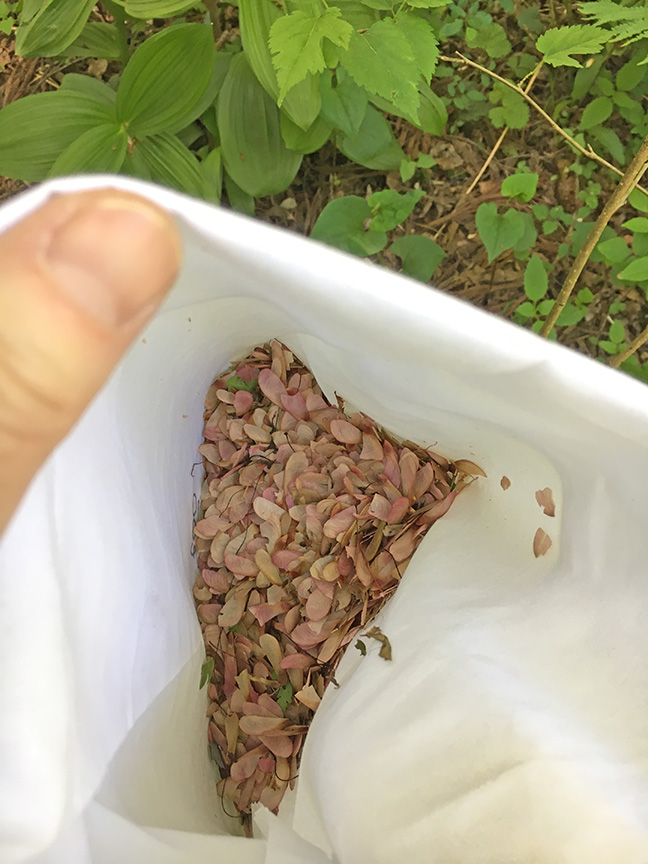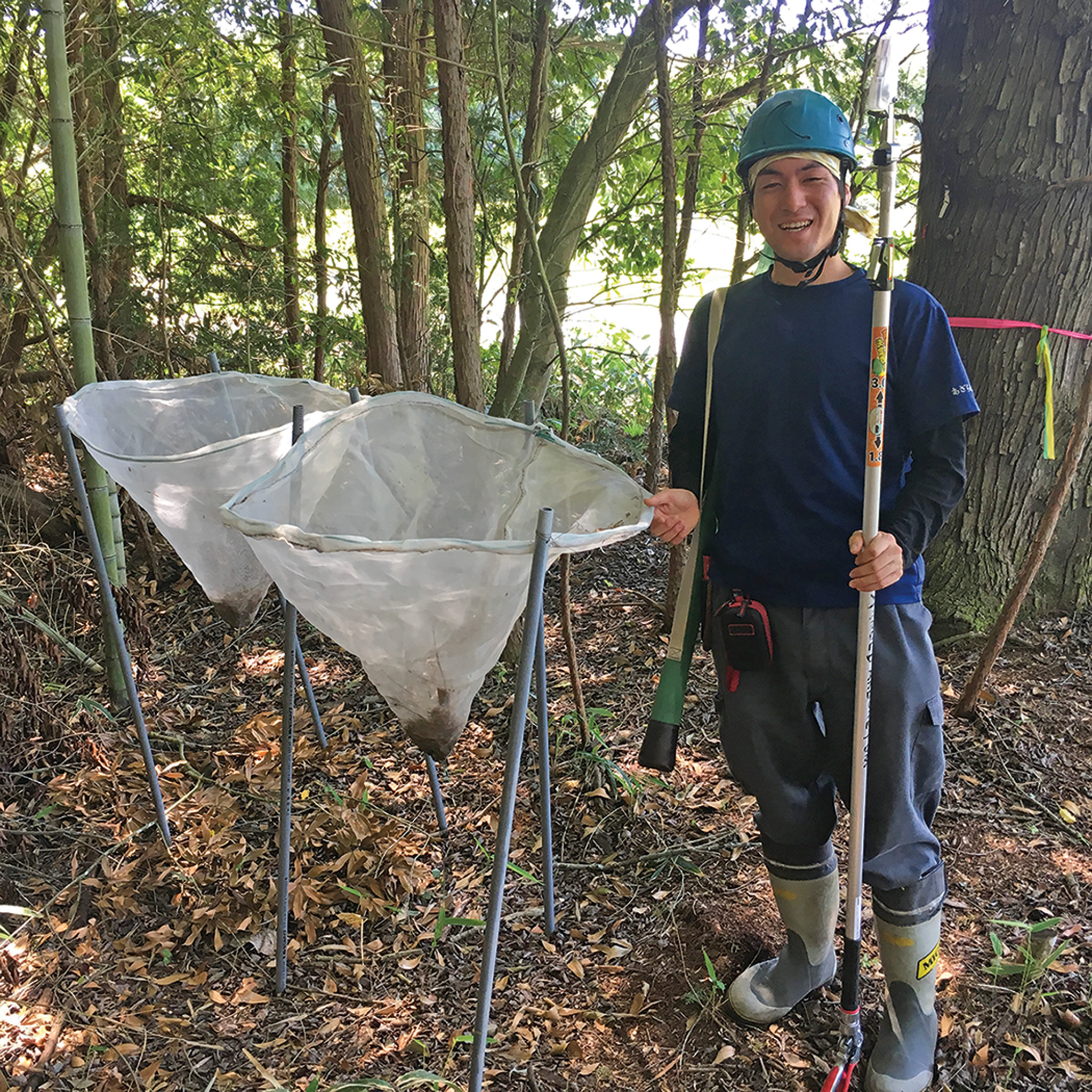It’s said that in life, timing is everything. Catching that last Orange Line train back to Jamaica Plain late on a Friday night. Cooking your fettucine to al dente perfection. Stumbling upon a tree in the wild, just as its fruits are perfectly ripe and about to shed. Many a time, my colleagues and I have encountered a target species in the woods, only to discover the fleshy fruits gobbled by birds or blown in the wind shortly before our arrival. I recall collecting Carpinus fangiana, a marvelous Chinese hornbeam, high above a river in northern Sichuan in 2016. The slightest breeze (or jostle of our pole pruner) sent the fruits cascading into the rushing torrents below. Luckily we nabbed half as many as those claimed by the wind. Because rain was on the horizon, I suspect we were but hours from coming up empty handed.

Sometimes perfect timing means showing up several months earlier than you typically might. Such was the case this past May, when I found myself in Japan collecting one of the country’s rarest of maples, Acer pycnanthum. Only about 1500 individuals of this species remain in the wild, limited to growing in special wetlands (seeps and floodplains) in central Honshu between 300 and 600 meters (1000 and 2000 feet) in elevation. But why collect it in May? Unlike a majority of the trees the Arboretum collects on expedition, the fruit of this species—the characteristic winged samara—ripens in mid-to-late spring.
Acer pycnanthum is just as rare in cultivation in the West, with just a few introduced lineages growing in gardens and arboreta worldwide. Previously, the Arboretum has attempted to grow the species ten times, each without success. Several individuals made it out of the nursery, but they perished a few years later, likely due to a combination of poor winter hardiness and possibly drought. A recent acquisition from 2018, donated by the Morris Arboretum, is a classic example of what we call “the botanical garden common flora,” where a single lineage passes around from garden to garden. The Morris plant came from the Dawes Arboretum in 2012, which in turn received it from the Morton Arboretum in 2011, which repropagated it in 2000 from a plant it accessioned from a wild source in 1964. Certainly, sharing germplasm is an important and necessary part of what we do as public gardens. But, with rare species in particular, it is essential to infuse the system with new lineages, which is a central tenet of the Arboretum’s 10-year collecting effort, The Campaign for the Living Collections.

Mineaki Aizawa, professor of forestry at Utsunomiya University, and his graduate student Tatsuhiko Shibano joined me in the field expedition to gather seed of the tree. These two proved fantastic collectors in September 2018 when I and others were on expedition in Japan, so I knew I was in good hands. As we arrived at the first population of A. pycnanthum in Sendanbayashi, Gifu Prefecture, I felt anxious with anticipation as we swiftly headed to the treeline, crossing between the freshly planted rice paddies.
Even from a distance, I could distinguish our maple from other broadleaved trees due to their grayish-green foliage color, particularly as the wind ruffled the leaves—the leaf undersides display a waxy, white bloom, much like those of its close North American relatives red maple (A. rubrum) and silver maple (A. saccharinum). The species’ similarity to these two native maples is uncanny—it was like sauntering up to a Massachusetts swamp and visiting familiar friends. The scene reminded me of a photograph taken by Arboretum explorer E. H. Wilson on October 30, 1914. He captured the trees, some 15 meters (50 feet) in height, growing at the edge of a swamp in modern-day Gifu (then Mino Province), raindrops hitting the water but not the heads of two of Wilson’s companions, who stand protected beneath wooden umbrellas.

Like its American relatives, Acer pycnanthum produces reddish flowers in late winter/early spring. In fact, despite the flowers being rather small, such is their profusion that the common name for species in Japanese (Hananoki) translates to “flowering tree.” As we approached the trees and looked up, we found them devoid of fruit: they had shed their pinkish-tan, winged samaras about a week earlier. Fortunately, there was nothing to worry about because Mineaki had deployed several seed-collection traps (imagine mesh laundry hampers) below the trees a few weeks before. As the fruits dispersed in the wind, they spun into the traps to await our arrival. Perfect timing, indeed—but with expert planning.

In another population near Bicchuubara in nearby Nagano Prefecture, we found trees in a rich forest, perched on a gentle slope fed by natural springs. Most of these trees had also shed their seeds, which were captured by the fern fronds below (nature supplied her own seed traps in this instance). However, a few trees still bore their fruits on long stalks, or peduncles, allowing us to collect voucher herbarium specimens with all the requisite components. Mrs. Noguchi, the owner of the property containing these trees, was proud not only to steward the rarities, but to share seeds with us.

These collections will play a number of pivotal ex situ conservation roles at the Arnold Arboretum and beyond. After our seeds germinate and the trees grow to transplantable size, we will of course add them to the permanent living collections where they can be shared with scholars and visitors who may never get the chance to see them in the wild. Seeing where the trees grow in nature will inform where we site them in the Arboretum—we will play close attention to its moisture needs, and ensure they are protected as much as possible in winter. We have also shared seed with other gardens and arboreta, as well as USDA’s National Plant Germplasm System’s Woody Plant Germplasm Repository, so that they may similarly enrich their collections. Experience has taught us the value of diversifying the number of gardens and environments attempting a given species’ propagation and cultivation. Where one may fail, another may succeed. And, when it comes to protecting plants of conservation value, the timing—now—is truly everything.
Originally published in Silva, Fall/Winter 2019-20. Silva is available biannually as a benefit of membership in the Friends of the Arnold Arboretum.
From “free” to “friend”…
Established in 1911 as the Bulletin of Popular Information, Arnoldia has long been a definitive forum for conversations about temperate woody plants and their landscapes. In 2022, we rolled out a new vision for the magazine as a vigorous forum for tales of plant exploration, behind-the-scenes glimpses of botanical research, and deep dives into the history of gardens, landscapes, and science. The new Arnoldia includes poetry, visual art, and literary essays, following the human imagination wherever it entangles with trees.
It takes resources to gather and nurture these new voices, and we depend on the support of our member-subscribers to make it possible. But membership means more: by becoming a member of the Arnold Arboretum, you help to keep our collection vibrant and our research and educational mission active. Through the pages of Arnoldia, you can take part in the life of this free-to-all landscape whether you live next door or an ocean away.
